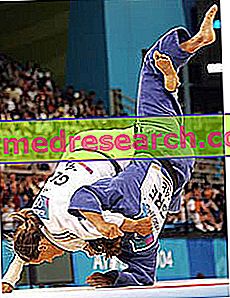By Simone Forte
Judo is a combat sport, and like most of these sports athletes have to fall into certain weight categories.
This means that in addition to a preparation based on improving muscular, circulatory and respiratory performance, it is also necessary to work on weight variation, trying to achieve a balance, as far as possible, between lean mass and fat mass.

With the same technique, the athlete in question will have an advantage, but if the challenger has a superior technique then the muscles are of little use, the challenger will try to exploit his weight deriving from the fat mass to use it in certain techniques such as throwing ballast .
This concept is valid only if the athlete with a lower lean mass will have a superior technical mastery.
When an athlete is prepared for professional competitions, she always tries to make him fall within the limit of the lower weight category; we take one of the seven men's categories, 73 - 81 kg, we will try to bring the athlete back into this category with a weight of 80kg, to ensure that already from the muscular point of view it has an advantage over an athlete weighing 74kg.
Obviously this concept is valid only if we take into account the body composition as previously mentioned.
This means that the athletes are not prepared only in the gym as far as the fights are concerned but they are followed meticulously over 24 hours, there is the technician who is in charge of the technical preparation, rather than mental, rather than food.
It is a team that moves behind the individual in order to win all together; erroneously many think that individual sports concern the single athlete but it is not so, in the competition phase the athlete is seen only but behind him there is always a team that works to achieve the goal (mission).
Another peculiarity in athletic training at 360 °, and that many neglect, is the psychological preparation; many forget that the body has a control center which is the mind, if the mind abandons the athlete for a single moment its potential falls dramatically.
Emotions enter the athlete as disturbing elements in the form of distractors, in anyone practicing a competitive sport at a competitive level, self-esteem, self-worth, but also the fear of winning (nikefobia) or the fear of losing can affect strongly the activity.
As for the muscular preparation, it is necessary to plan all the training based on the dates of the competition and the technical preparation, first of all to be trained is the maximum strength, after which to carefully evaluate based on the technical characteristics of the athlete, if it is necessary to increase the resistant force rather than the explosive force or vice versa taking into account that they are inversely proportional and that is that as one increases, the other decreases.
Generally every athlete has some preferential techniques that he feels more his and that he manages to make run with extreme ease, but considering an athlete with complete knowledge, he will try to train more resistant force than explosive force.
In this sport it may happen that the judoka will have to fight for the entire duration of the meeting, which for men is 5 minutes while for women it is 4 minutes.
Fighting for the entire duration of the match means that there has been no knockout and no abandonment by the opponent, so you need a good resistant strength that allows us to maintain isometric contractions alternating with sudden changes, as well as explosiveness in the technical execution such as projections.
At this point we can deduce that the optimal preparation for a judoka is to train the maximal force beforehand (therefore not increasing the hypertrophy to avoid having a weight gain if you are already at the category limit), then maintaining a correct balance between explosive force and resistant strength, keeping the latter slightly higher.
Hypertrophy is the increase in the size of the muscle cells, larger muscles mean greater weight and this must be carefully evaluated by the athletic trainer, in an example cycle we will try to increase the maximum strength to be able to increase also the hypertrophy, if need be, then return to the maximum strength and then cure resistance and explosiveness.



